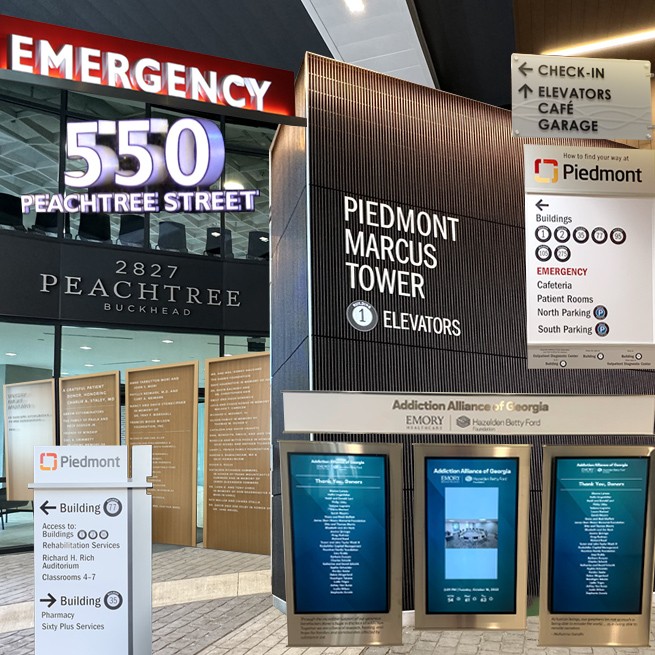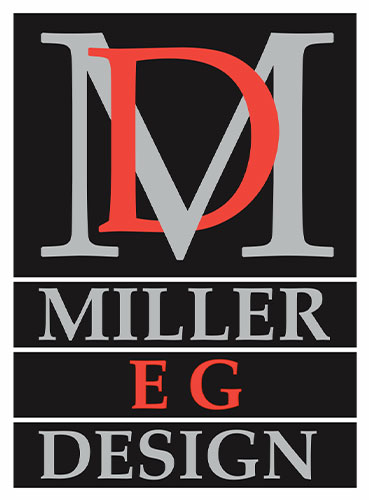Miller EG Design
BETTER WAYFINDING
Our Brand

OUR BRAND STATEMENT
Miller EG Design is dedicated to enhancing navigation experiences by providing superior signage and graphics, ensuring individuals can confidently find their way without frustration, anxiety, or the risk of getting lost.
OUR BRAND POSITION
We offer an innovative blend of strategies and products aimed at efficiently delivering and managing signage and graphics, ensuring timely navigation for individuals. This approach not only facilitates seamless journeys but also contributes to improved economic outcomes for all stakeholders involved.
- Call Us Today
OUR BRAND ATTRIBUTES
The brand attributes of wayfinding services play a crucial role in shaping the perception and effectiveness of the navigation solutions offered. Here are some key brand attributes that contribute to successful wayfinding services:
1. Trustworthiness:
- Reliability: Ensure accurate and up-to-date information to build trust in the effectiveness of the wayfinding system.
- Consistency: Provide a consistent and dependable experience across different locations.
2. User-Friendly:
- Intuitiveness: Prioritize user-friendly designs that are easy to understand and navigate.
- Accessibility: Make the wayfinding system inclusive and accessible to individuals with diverse needs.
3. Innovative:
- Technology Integration: Embrace innovative technologies, such as digital maps and augmented reality, to enhance navigation experiences.
- Adaptability: Stay abreast of technological advancements to continuously improve and update the wayfinding services.
4. Efficiency:
- Time-Saving: Position the wayfinding services as a solution that saves time and enhances overall efficiency.
- Optimization: Regularly assess and optimize the system for maximum effectiveness.
5. Branding and Aesthetics:
- Visual Appeal: Design aesthetically pleasing wayfinding elements that align with the brand and enhance the overall environment.
- Branded Experience: Ensure that the wayfinding system reflects the brand's identity and values.
6. Customization:
- Adaptability: Offer customizable solutions that can be tailored to specific environments, industries, or user preferences.
- Personalization: Provide options for users to personalize their navigation experience when applicable.
7. Clear Communication:
- Simplicity: Communicate information clearly and concisely to minimize confusion.
- Multilingual Support: Cater to diverse audiences by offering multilingual support when necessary.
8. Community-Centric:
- Local Relevance: Consider local context and community feedback in the design and implementation of wayfinding services.
- Community Engagement: Involve the community in the development process to ensure the system meets their needs.
9. Environmental Responsibility:
- Sustainability: Incorporate sustainable materials and practices in the design and maintenance of physical wayfinding elements.
- Green Design: Consider the environmental impact of the wayfinding system and strive for eco-friendly solutions.
10. Customer Support:
- Responsive Support: Provide responsive customer support to address user inquiries and issues promptly.
- Training and Resources: Offer training materials and resources to help users make the most of the wayfinding services.


By emphasizing these brand attributes, wayfinding services can establish a positive reputation, enhance user satisfaction, and contribute to the overall success of navigation solutions.
OUR BRAND PILLARS
Creating effective wayfinding solutions involves establishing brand pillars that emphasize clarity, usability, and a positive user experience. Here are some potential brand pillars for better wayfinding:
1. Clarity:
- Simplicity: Ensure simplicity in design and information presentation to avoid confusion.
- Consistency: Maintain a consistent visual language and messaging across all wayfinding elements.
2. Usability:
- Accessibility: Prioritize inclusivity by considering diverse needs and abilities in design.
- Intuitiveness: Strive for an intuitive user interface that minimizes the need for instruction.
3. Innovation:
- Technology Integration: Explore and implement cutting-edge technologies for enhanced navigation experiences.
- Adaptability: Stay open to evolving technologies and design trends to improve wayfinding solutions continually.
4. Engagement:
- User-Centric Approach: Prioritize the needs and preferences of users in the development of wayfinding systems.
- Community Involvement: Involve the community in the design process to ensure local insights and preferences are considered.
5. Efficiency:
- Optimization: Continuously analyze and optimize the wayfinding system for efficiency and effectiveness.
- Time-Saving: Emphasize the role of wayfinding in saving time and facilitating smooth journeys.
6. Aesthetics:
- Visual Appeal: Blend functionality with aesthetic appeal to create visually pleasing wayfinding elements.
- Branded Experience: Ensure that wayfinding elements align with the overall brand aesthetic for a cohesive experience.
7. Reliability:
- Durability: Prioritize durable materials and technologies to ensure the longevity and reliability of wayfinding elements.
- Accuracy: Guarantee the accuracy of information provided through regular maintenance and updates.
8. Environmental Responsibility:
- Sustainability: Integrate sustainable practices in the design and production of wayfinding materials.
- Green Design: Consider environmental impact in the placement and maintenance of physical wayfinding elements.
9. Collaboration:
- Interdisciplinary Collaboration: Foster collaboration between designers, architects, and other stakeholders for comprehensive wayfinding solutions.
- Client Involvement: Engage clients and end-users throughout the process to align solutions with their specific needs and expectations.
By incorporating these brand pillars into your wayfinding strategy, you can create a robust and effective system that prioritizes the user experience and contributes to positive outcomes for all stakeholders involved.
WHAT FACTORS CONTRIBUTE TO BETTER WAYFINDING
Lets understand that technology is only a part.
Effective wayfinding is influenced by a combination of design, communication, and user-centric factors. Here are several key factors that contribute to better wayfinding:
1. Clear and Simple Signage:
- Legibility: Ensure that signs are easily readable from a distance, considering factors like font size, contrast, and lighting.
- Conciseness: Use clear and concise language on signage to convey information without overwhelming the user.
2. Consistency:
- Visual Language: Maintain a consistent visual language across all wayfinding elements to reduce confusion.
- Color Coding: Implement consistent color coding to signify different categories or types of information.
3. User-Centric Design:
- Understanding User Needs: Design solutions based on an understanding of the needs, preferences, and behaviors of the target users.
- Accessibility: Ensure that wayfinding systems are accessible to individuals with diverse needs and abilities.
4. Technology Integration:
- Digital Mapping: Incorporate digital maps and navigation technologies for real-time guidance.
- Augmented Reality: Explore augmented reality solutions to overlay digital information onto the physical environment.
5. Effective Placement:
- Strategic Placement: Position signage and wayfinding elements at key decision points to guide users effectively.
- Visibility: Ensure that signs are visible and unobstructed to avoid confusion.
6. Logical Flow:
- Hierarchy of Information: Establish a clear hierarchy of information to guide users through a logical sequence of decisions.
- Progressive Disclosure: Provide information progressively, revealing details as users move through the space.
7. Feedback Mechanisms:
- Confirmation Signs: Include signs that confirm users are on the right path to boost confidence.
- Interactive Elements: Integrate interactive elements, such as touchscreens or information kiosks, for more personalized guidance.
8. Environmental Context:
- Contextual Information: Consider the broader environmental context and incorporate landmarks or contextual cues into the wayfinding system.
- Adaptability: Design solutions that can adapt to changes in the environment or user needs.
9. Training and Education:
- User Training: Provide training or educational materials to help users understand and navigate the wayfinding system.
- Onboarding Support: Offer assistance to new users to familiarize them with the wayfinding process.

10. Maintenance and Updates:
- Regular Maintenance: Ensure that physical signage is well-maintained, and digital systems are regularly updated.
- Dynamic Information: Provide real-time information and updates to reflect changes in the environment or facility.
11. Community Involvement:
- Stakeholder Feedback: Involve stakeholders and end-users in the design and improvement process to incorporate local insights.
- User Testing: Conduct user testing to identify potential issues and refine the wayfinding system based on user feedback.
By considering these factors in the design and implementation of wayfinding systems, organizations can create solutions that are user-friendly, efficient, and contribute to a positive overall experience for individuals navigating a space.
